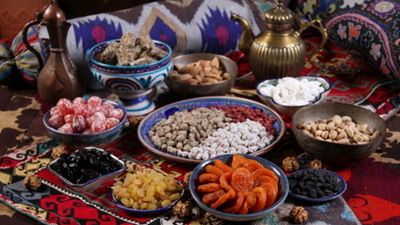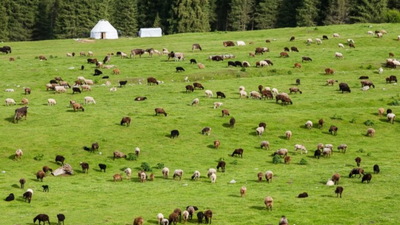The Kyrgyz Yurt
Central Asian nomadic civilizations, over the several thousand years of their existence, developed the yurt, a dwelling which perfectly reflects their worldview and way of life. A yurt is a portable, round tent covered with skins or felt. The turkic word “jurt” can mean nation, homeland, or campsite.
The earliest records of the yurt are found in Chinese sources. In the Chinese records of the 2nd century BC, Huainanzi defined the yurt as a “dome cabin”. The oldest images of the yurt are preserved on funerary statuettes of the 6th century from northern China, and on rock carvings in the gorges of Eastern Kazakhstan.
There are two types of yurts - the Turkic and the Mongolian. They differ in the shape of their dome. The Turkic yurt uses steam-bent wooden framing for the dome construction. Thus, there is no need to install a support post inside the yurt. In the Mongolian yurt, however, the dome requires the support of a post.
The Turkic type of yurt is commonly found spread among the Turkic peoples of Central Asia and Siberia, who lead a nomadic or semi-nomadic way of life, while the Mongolian type, called a “ger”, is typically found among the nomads of Mongolia, Tuva, Buryatia, Kalmykia and Tibet.
The yurt has been used by nomads for over three thousand years, that is why it is considered to be perfectly adapted to the nomadic way of life. The key advantages of the yurt are its universality and its mobility. Despite a yurt’s size, it can be easily taken down or set up in less than an hour. This made the yurt especially useful for both soldiers and nomads.
The yurt was also the most accessible form of housing for nomads because they had easy access to all the necessary materials for construction, such as felt, leather and wood. In addition, felt offers extra protection against the harsh climate of the mountains and steppes as it keeps cool during the warm summer and warm during the cold seasons.
The size, ventilation and illumination of the yurt can be easily adjusted. In hot weather, for additional ventilation, it is easy to open the sunroof simply by raising the side rope. In general yurts provide excellent air circulation because of the round shape of the walls.
Yurt installation has several steps, with most of the responsibility for setup given to the women. The first step is to set up the wooden frame and install the doorframe, which is joined to the expanding lattice wall-sections called kerege. A yurt of medium size usually consists of four kerege. The expanding lattice wall-sections are fixed by special straps made of camel and bull skin, and attached to the doorframe with woven belts (terma) decorated with ornaments.
Next comes the tunduk. The dome of the yurt is created with special ceiling boards called uuk. Following this, the door is placed within the frame. In ancient times, the door was typically a felt mat.
The next step is to "wrap up" the finished frame with felt, mats and ribbon. At first, two long mats are tied around the expanding lattice wall-sections for insulation. Next, the dome of the yurt is covered with two felt carpets called uzuk. For durability, the inner and outer parts of the yurt are tied with a double fiber rope which are covered with felt called turd. In the center of the dome a felt four-sided figure is fixed. The floor of the yurt is covered with colorful felt carpets called ala-kiyiz and shirdak, which are richly decorated with national designs and animal figures.
The final step is decorating and arranging the interior. This is an important stage in the installation of the yurt as it completely reflects the worldview of the nomads for whom the yurt was not only a dwelling but a small model of the universe.
The space inside the yurt forms a single room that is shared between all family members, but it is conceptually divided both horizontally and vertically by the nomads. The horizontal division is connected to the use of space and gender. The male half is called the er-zhak and is to the left hand of the entrance. This is where men keep their weapons, horse and hunting gear. The women's section is the right half of the yurt, where the kitchen utensils, foodstuffs and baby's bed are typically kept.
The space in the center is shared by both women and men and is called the tөr. This also a place of the hearth and symbolizes the welfare of the house, so this place is considered the most honorable in the yurt and is used for the reception of guests. The tөr is richly decorated and furnished with objects embodying the family's prosperity: the most valuable good, carpets, furs and other possessions, and Muslims nomads often place the Koran here.
The vertical division of the space within the yurt is connected to the spiritual element. The nomads divided the inner space of the yurt into three vertical zones. The floor represents the earth, the walls personify the world of people, and the dome symbolizes the heavenly host. The final element, the tunduk or dome cap, is a personification of Tengri, God of the Sky. The tradition of calling Tengri God was preserved among the Turkic nomads and, following the adoption of Islam, many Turkic languages feature the use of the name “Tengri” for God along with the words “Allah” and “Kudai” (Most High).
Today, each ethnic group has their own name for the yurt. For example, the Kazakhs call the yurt a “kiyiz” (felted house), the Kyrgyz call it a “bos” (gray house), the Turkmen call them “ak / kara” (white / black house) and the Tuvans say “өg” (house), but for all of these groups their term for the yurt means house. The nomads believed that people should live in harmony with the world, and living in yurts allowed them to follow nature’s changes. In this way, the yurt symbolizes freedom of movement and the true culture of the nomads.



